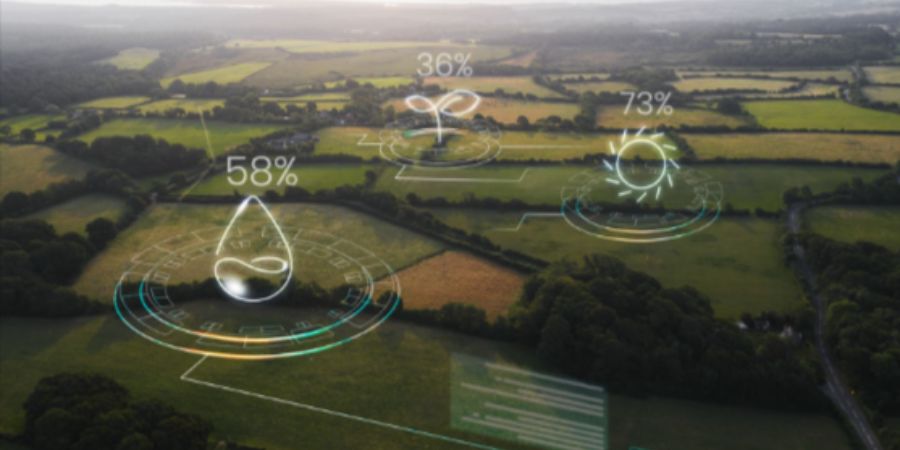According to the United Nations, our planet’s population is expected to reach 9.7 billion by 2050. Considering the fact that climate patterns have massively changed and continue to shift, overpopulation and food production are becoming the most acute issues for today. Moreover, resources on our planet are not unlimited. For instance, water, oil, natural gas, phosphorus, and coal are among those that we are going to run out of. This means that it is no longer possible to rely on traditional methods of extraction and consumption to survive on this planet.
Digital solutions and space technologies are crucial to managing the possible food production crisis. And what’s more important is that these technologies must be used on all levels, from local farmers to multinational corporations. It is vital to create a farming solution powered by agriculture API for the food industry. Now we’ll take a closer look at what this approach entails and how it can enable producers to gain precise farming insights and redefine modern agriculture.
What Is an Agriculture API?
An agriculture API works like a bridge that helps different farming tools and apps share information with each other. Instead of checking weather updates in one place, satellite images in another, and soil sensors somewhere else, the API pulls it all together. Farmers can check what’s happening or going to happen on their fields, whether it’s the weather forecast or soil conditions, and then check market prices. And all this is possible without having to jump between different systems. Instead of dealing with scattered or confusing data, farmers, agronomists, and agri-tech developers get the information in a clear, usable format through the apps and tools they already use.
Here is a simple example. A farmer needs information about weather, crop growth, and soil moisture levels. This data can be obtained from various sources by establishing separate connections to each provider and utilizing dedicated software. Instead of manually collecting data from all the sources, a farming app can simply connect to an agriculture API. The benefit is that this API software gathers, processes, and organizes the information into a clear format without the need to manage complicated spreadsheets or raw numbers.
How farmers can use agriculture APIs in real life:
- Crop monitoring: By connecting to satellites, an API can spot early signs of crop stress or poor plant health, giving farmers time to act before yields are affected.
- Irrigation control: Instead of guessing when to water, farmers can rely on soil and weather data delivered through the API to create smart watering schedules that save both water and money.
- Market access: Since crop prices fluctuate daily, APIs provide real-time updates, enabling farmers to choose the optimal moment to sell their harvest.
- Traceability: APIs also make supply chains more transparent, recording each step from farm to market so buyers know exactly where their food comes from.
Why Build Solutions with Agriculture APIs?
An agricultural API is a necessity for modern farming producers if we aim to provide stable supply chains. Three core benefits stand out:
- Precision and Accuracy
Instead of relying on traditional estimates, farmers gain access to high-resolution data from satellites, IoT sensors, and drones. Signs of crop stress, soil moisture, or data on vegetation are becoming more accurate down to a few percentage points. For instance, according to the FAO report, precision irrigation guided by digital data can reduce water usage by up to 30%. - Access and Inclusivity
Thanks to APIs, agriculture software is accessible even to small farms and local growers. For example, a farmer in Kenya with nothing more than a basic smartphone can access weather forecasts, crop health updates, and market prices, just like a large-scale farm in Europe. - Integration and Flexibility
Agriculture APIs work smoothly with existing systems: farm management apps, irrigation controllers, or even autonomous drones. As a result, your existing farming infrastructure will not need many adjustments to maintain the agriculture data obtained from new API resources.
The Key Advantages of the Best Agriculture API in 2025
Technologies in agriculture are becoming vital. For instance, the artificial intelligence market in agriculture is projected to reach $11.2 billion by 2031. The main reason is the same – the increased food demand and labor shortages. Agriculture API plays in the same league. By the end of 2025, it will have become an indispensable tool for ensuring both farm profitability and sustainability. The API benefits are rather clear and touch various aspects of agricultural activities:
- Resource Optimization
APIs deliver precise soil moisture and nutrient data, allowing farmers to schedule irrigation and fertilization with exact timing. This reduces fertilizer runoff, saves up to 20-30% of water use, and enhances long-term soil health. - Crop Health, Disease & Pest Monitoring
API provides real-time satellite imagery and AI-powered analysis. This allows farmers to detect crop stress earlier, apply necessary nutrients to plants, or apply fertilizers in a timely and accurate quantity. - Forecasting & Risk Mitigation
Farmers can have a precise weather forecast with an agriculture weather API to plan sowing, irrigation, and harvesting while reducing risks from unexpected droughts, frosts, or heavy rains. - Marketplace Integration & Transparency
Digital marketplaces can now be on farmers’ fingertips with the help of APIs. There is no need to make a research in differend sources, it is just on your device’s screen. This ensures fair pricing, strengthens food safety, and streamlines inventory management.
Building Smarter Farming Solutions With API
Farming isn’t just about seeds and soil anymore. Real-time information and fast reactions to market fluctuations and weather changes have become essential for farmers’ yields as well. API tools give farmers control, clarity, and confidence, whether they run a tiny family plot or a larger commercial farm. By bringing together data from satellites, sensors, and apps, farmers can care for their land more efficiently and sustainably, and help ensure that healthy, reliable food reaches all of us.
______________
Author :
Vasyl Cherlinka is a Doctor of Biosciences specializing in pedology (soil science), with 30 years of experience in the field. With a degree in agrochemistry, agronomy and soil science, Dr. Cherlinka has been advising on these issues private sector for many years.



